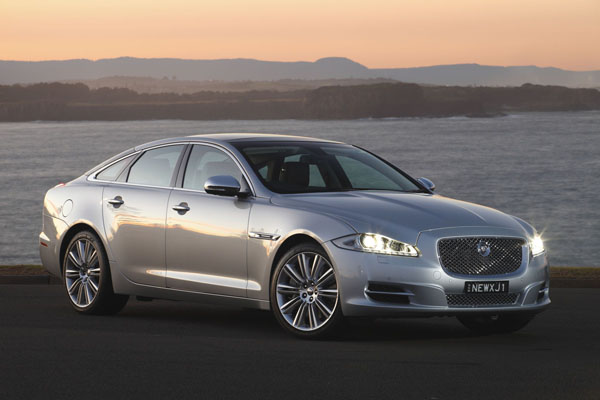
2010 Jaguar XJ
Though the body has ultra-modern styling, the interior has could be optioned with
traditional leather-and-wood options – the best of both worlds that please the traditionalists
who loved the original XJ models. There’s a nice wrap-around effect that carries the dash
area neatly into the doors.
So good is the shape of the 2010 Jaguar XJ that it’s largely unchanged nine years later.
There were minor facelifts in 2014 and 2015, but show a non-car person a 2010 Jaguar
saloon and tell them it’s a 2018 and they won’t doubt you.
However, the end is nigh and the factory stopped producing the XJ midway through 2020.
Jaguar Land Rover CEO Thierry Bollore has said “the planned Jaguar XJ replacement will
not form part of the line-up”.
As of mid-2008 Jaguar has been controlled by Indian company, Tata. The Indians have an
excellent understanding of English traditions – indeed, they can be more English than the
English. So, the British marque looks is in good hands, with the engineers and stylists
being pretty well left alone other than, presumably, working within budgets.
A drawback in the older Jaguars, is the tight interior space. These are low-slung sports
saloons, not sedans. The post 2010 XJs are better than the old ones, but check out the
back seat if you are planning to carry tall adults on a routine basis. The LWB (long
wheelbase) models are popular in Australia, you may be asked to pay a fair bit more, but
we reckon it’s worth it if the back seat is to be used by anything other than junior travellers.
Petrol engines are 3.0-litre V6 and 5.0-litre V8. The latter is offered in supercharged format
in the high-performance Jaguar XJR.
2012 Jaguar XJ Sport
Transmission is through a six-speed automatic until 2013 when an eight-speed unit was
introduced. The latter is a better buy and worth paying extra for. The six-speed has an
interesting shifter that offers the driver manual selection of a type we had never seen
before.
A 3.0-litre turbo-diesel in V6 format was an interesting option, we’ve noticed quite a lot for
sale in Australia at the moment. Perhaps because owners are having troubles, but more
likely because there’s a solid swing away from diesel cars in the UK and Europe.
There’s some diesel engine noise at idle, particularly when the engine’s cold, but from
inside it’s virtually as smooth and quiet as a petrol unit. The diesel has plenty of torque that
makes for effortless driving.
Servicing and spare parts are on the high side so don’t fall for the trap of putting all your
money into buying the car and then finding yourself unable to keep it in the manner in
which it is accustomed.
Insurance costs are about average for a prestige car that sold in relatively small numbers.
There’s not a great deal of difference in costs but it’s still worth shopping around for a
good deal. As usual we suggest it’s smart to build up a history with one insurance
company rather than flitting from place to place.
2016 Jaguar XJ
WHAT TO LOOK FOR
By this time Jaguars were significantly more reliable than in the past, but it’s still smart to
be wary. Do your own initial inspection by all means, but always invest in a professional.
Ideally one with formal Jaguar training.
Make sure the engine starts easily and idles smoothly and quietly. On your road test be
sure it doesn’t hesitate and there are no smoke fumes from the exhaust.
Check that the brake fluid has been changed on schedule. Not doing so can lead to
expensive troubles.
Watch out for an automatic transmission that’s slow to go into gear and/or which hunts
from gear to gear unnecessarily. Hill climbing for an extended distance usually brings out
this fault.
Damaged aluminium panels may have to be repaired by a specialist so be sure to get a
quote from an expert, even for the smallest scratches and dents.
Drive on a rough road and listen for squeaks and rattles. We tested some with a sunroof
that moved in its housing during these conditions.
HOW MUCH?
Expect to pay from $24,000 to $33,000 for a 2010 Jaguar XJ Premium Luxury; $33,000 to
$45,000 for a 2011 V8 Portfolio; $43,000 to $57,000 for a 2015 Premium Luxury; $52,000
to $69,000 for a 2016 Portfolio; $64,000 to $85,000 for a 2013 V8 Supersport; $76,000 to
$102,000 for a 2016 V8 Autobiography; $84,000 to $113,000 for a 2017 Portfolio;
$103,000 to $139,000 for an XJR Supercharged V8; and $114,000 to $152,000 for a 2020
Premium Luxury.
CAR BUYING TIP
Prices are all over the place during these unusual times so you might be able to grab a
bargain. It pays to have the money on tap so you put in a low offer.
RECALLS: To browse recalls on all vehicles go to the ACCC at:
www.productsafety.gov.au/products/transport/cars/